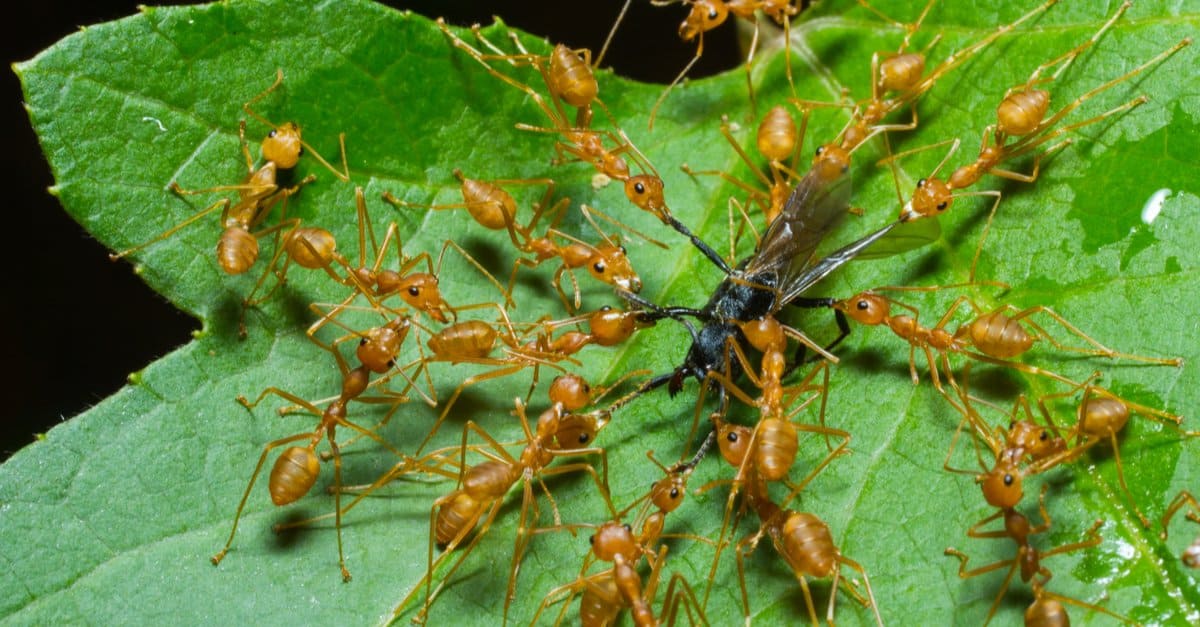The world of ants is diverse and fascinating, a microcosm where the struggle for survival plays out every day. It’s common knowledge that ants are industrious scavengers, collecting whatever food they can for their colonies. But what many may not realize is that ants are also fierce predators, hunting down and consuming a variety of other insects. In this comprehensive look, we explore the different types of insects ants prey upon, shedding light on their predatory habits and tactics.
Understanding Ants as Predators
To truly understand ants’ predatory behaviors, we must first delve into their social structure, biology, and various hunting tactics.

Social Structure and Its Influence
Ants live in colonies, comprising of worker ants, soldiers, and a queen, each playing a crucial role in the colony’s survival. These highly organized societies provide the ants an edge in their predatory behaviors. They can organize complex hunting expeditions, overwhelm prey using sheer numbers, and transport their kills back to the nest efficiently.
Ant Biology and Predation
Ants’ physical attributes also aid them in predation. Sharp mandibles allow them to grip and dissect their prey, while their exoskeleton provides ample protection from retaliation. Some ant species also have stingers or can spray formic acid, both of which can be used offensively in hunting.
Hunting Tactics of Ants
Different ant species employ various hunting strategies. Some ants are ambush predators, lying in wait and striking swiftly when the prey is within their grasp. Others may hunt in groups, overwhelming their prey with sheer numbers. Army ants, for example, are known for their aggressive group hunting techniques, swarming over and consuming anything in their path.
Types of Insects Ants Prey Upon
Ants are opportunistic predators. They prey upon a wide variety of insects, which we will delve into in the following sections.
Preying on Termites
Termites are one of the most common prey for many ant species. The antagonistic relationship between ants and termites is well documented. Notable examples include the fierce African driver ants that have been known to prey on termites in massive numbers.
Termites provide a rich source of protein for the ants, and their relatively soft exoskeleton makes them easier to kill and transport. Some ants have also evolved specialized hunting strategies to overcome termite defenses, such as tunneling into termite colonies or launching surprise attacks.
Aphids and Other Soft-Bodied Insects
Aphids and other soft-bodied insects like caterpillars are another primary food source for many ant species. Interestingly, ants have developed a mutualistic relationship with aphids, farming them for their sugary secretions known as honeydew.
However, when protein needs are high, particularly when larvae are present in the colony, ants may turn on their aphid livestock. Similar predatory behavior is observed towards caterpillars and other soft-bodied insects.
Spiders: An Unexpected Prey
Many ant species also prey on spiders, despite the significant risk involved. This predation often involves group hunting to overpower the spider, using their numbers and venom to overcome the arachnid’s defenses. Some ants, such as the aptly named ant-eating spider, have even been observed to mimic ant pheromones to get close to their prey.
Ants Predation Impact on Ecosystems
The predatory behavior of ants has far-reaching effects on ecosystems, influencing the population dynamics of their prey species and contributing to biodiversity.
Population Control
By preying on a variety of insects, ants play a significant role in controlling these populations. Their predation can help prevent outbreaks of pests like termites or aphids, benefiting the ecosystem at large.
Biodiversity and Ant Predation
Ants’ predation also influences biodiversity. It exerts selective pressure on their prey, driving the evolution of various defense mechanisms, such as chemical defenses in termites or physical defenses in beetles. This predator-prey interaction promotes the diversity of life strategies and adaptations in the insect world.
Concluding Thoughts on Ant Predation
Ants, often overlooked due to their size, are crucial players in our ecosystems. Their predatory behavior, fueled by their social structure, physical attributes, and hunting tactics, has a significant impact on the insect world, controlling populations and driving the evolution of different life strategies.
In the intricate web of life, ants prove that size does not equate to significance. Their predatory behaviors reveal a complex and fascinating aspect of their lives, reminding us of the constant interplay of species in the pursuit of survival.